In 2013, shortly after the rapid rise of Man City under their new ownership, City Football Group was founded with the aim of building a global network of football clubs. The interests behind this global network ranged anywhere from commercial purposes to sporting development. Commercially, the City Group brand has drastically grown globally over the last decade, with clubs being acquired in Spain’s La Liga, France’s Ligue 1, the USA, Australia, Brazil, Uruguay, and more. Additionally, there were various sporting interests behind the construction of this global network.
Success (and its financial consequences) is perhaps the most obvious one, with Man City dominating the Premier League in its golden era. The development and exchange of talent is another clear interest, with numerous promising stars from South America being signed and loaned across the network over the last few years. However, there is another sporting dimension which may not be as recognised as the others.
The globalisation of a football ideology has been a clear motive behind City Group’s global network. Similar to its business strategy, City Group’s football clubs play with a scientific, rational, and analytical approach. On the pitch, with Pep Guardiola leading the line, Positional Play has been the vehicle through which this strategy is carried out. In addition to Man City, this was clearly adopted at New York City FC, and now at Bahia in Brazil.
Once the acquisition of Bahia became official in late 2022, City Group immediately hired Portuguese manager Renato Paiva. Additionally, through meticulous recruitment in the transfer window, the squad went through a complete revolution. With the state championships well underway, Renato Paiva’s newly formed Bahia have already had some time to develop.
After 11 games, Paiva’s tactical approach is clear, and there is no surprise in this area. In this tactical analysis, we will take an in-depth look at Bahia’s tactics under Renato Paiva in 2023. In and out of possession, this analysis will break down the key principles and ideas behind Renato Paiva’s tactics.
Formations and squad
Before diving into the tactics, it is important to provide context by understanding their formations and squad development. In his 11 games in charge so far, Renato Paiva has kept it fairly simple. The Portuguese manager has mostly played with a 4-2-3-1, and at times, slightly modified it into a 4-4-2. However, the initial formation tends to become quite irrelevant in and out of possession.
While goalkeeper Marcos Felipe signed from Fluminense, there were some key signings in the defence. Kanu and Raul Gustavo arrived from Botafogo and Corinthians, respectively, and both will provide immediate quality at the centre-back position. Additionally, left-back Jhoanner Chávez is an extremely promising 20-year-old who arrived from Ecuador’s Independiente Del Valle.
Nicolás Acevedo arrived from New York City FC to significantly upgrade the midfield, and young stars Diego Rosa and Kayky came on loan from Man City. Finally, Biel is another promising talent who arrived from Fluminense.
On top of these key signings, City Group have brought in a few more precise additions. Heavily considering their tactical style, Bahia’s squad has been completely upgraded.
Spatial guidelines
Renato Paiva has adopted a textbook Positional Play model at Bahia, and so far, it has proven successful. They have been able to control matches with 62.93% possession and 36 positional attacks per 90, at the time of writing. This control is very resembling of City in the Premier League, albeit against much weaker opposition. Nonetheless, the initial possession-based style is already implemented at Arena Fonte Nova.
In this approach, the high volume of possession is merely a tool through which Paiva’s men carry out their principles. With only 8.95% of their 472.55 passes per 90 being long, this progression is clearly done in a very controlled manner. This control is both in their passing style, which is very certain and programmed, and in their movement, adhering to zonal guidelines to maximise the pitch and manipulate both space and their opponents.
Let’s take it one step at a time, and first look at their initial setup. At a first glance, they often set up with a first line of three spread across the three central channels, a single deep-lying midfielder in the central channel, and two advanced midfielders in each half-space. In the ball-side wide area, there is the fullback and the winger. Depending on where the ball is, either one of them could move into the half-space, but if so, the other must stay wide.
In this first instance, the line of three is formed by one of the defensive midfielders dropping in between the centre-backs while the other becomes a single pivot. The attacking midfielder shifts into the left half-space while the opposite winger moves into the right half-space.
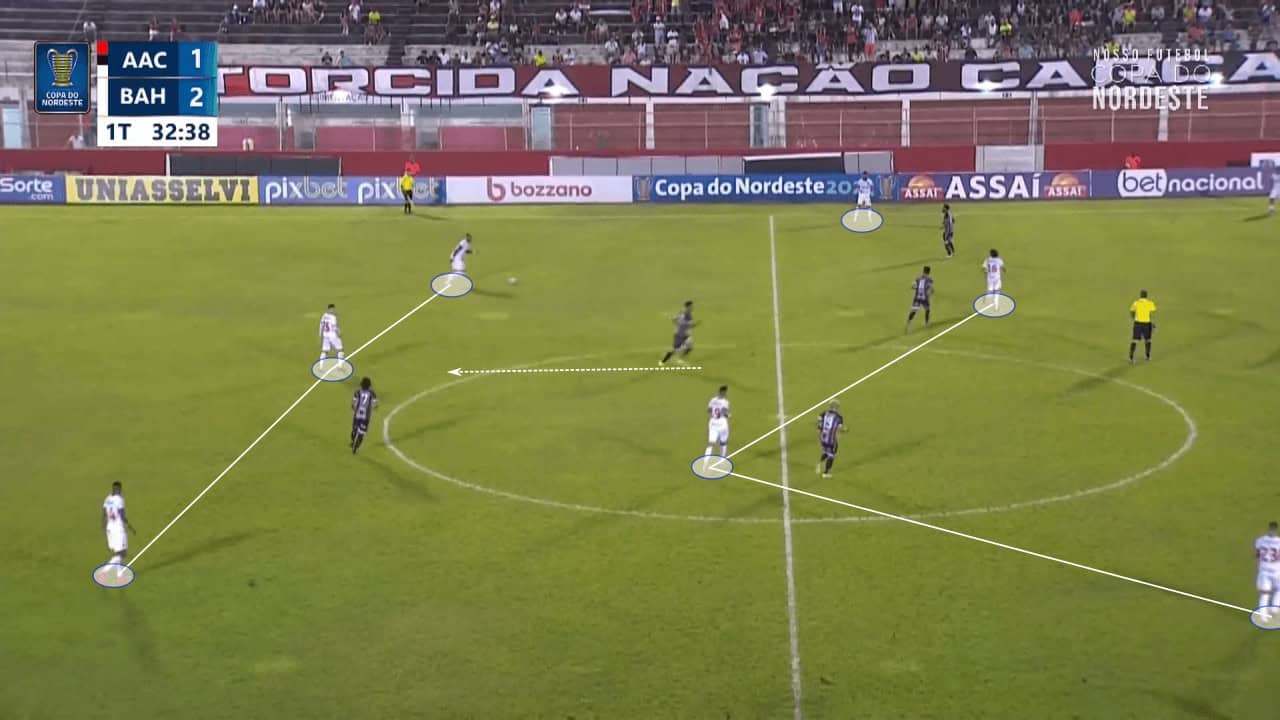
However, in this second example, we can see a completely different variation. The right-back remains deeper to form this line of three, and one of the defensive midfielders pushes up into one of the half-spaces with the attacking midfielder in the other. A similar setup is achieved, but it is formed in a completely different manner.
This illustrates Positional Play at its best. There are spatial or zonal guidelines to which the players must adhere, however, it is not rigid as to who goes where. Obviously, some consistent patterns will emerge, but they can change from possession to possession, as long as the balance is maintained, and the spaces are respected.
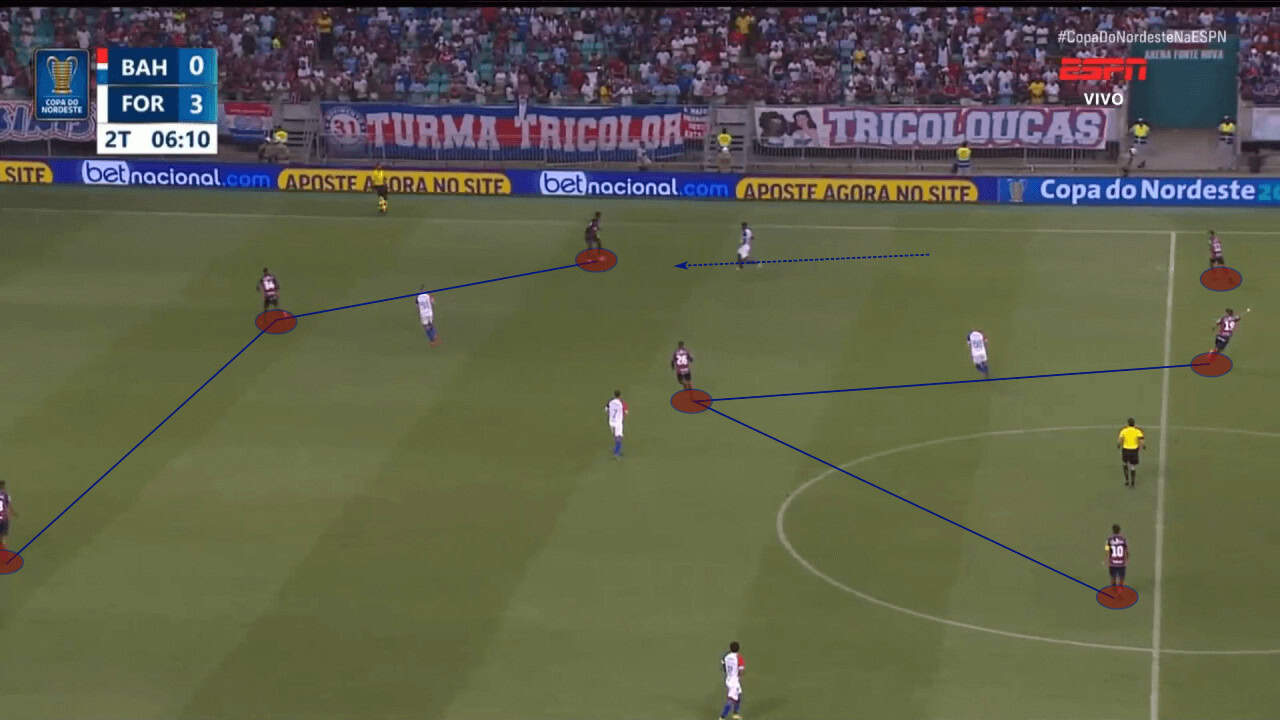
On a larger scale, we can see these zonal rotations below. First, in the bottom right, the left-back has pushed up into a defensive midfielder position while the defensive midfielder has shifted wide. Up top, the centre-forward drops in to check for the ball and the attacking midfielder pushes up to occupy the space left behind. On the opposite side, as the right-back pushes high and wide, the right winger drops into the half-space.
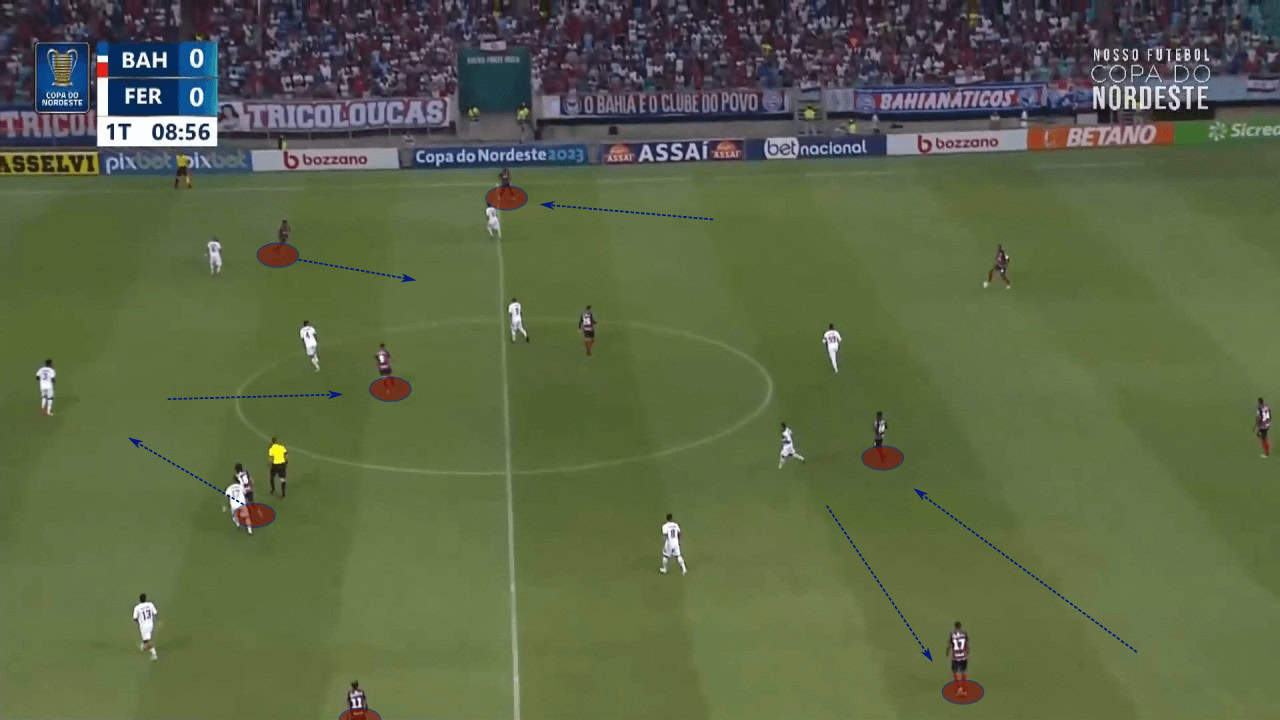
With these spatial guidelines, maximum width is always maintained in possession. With such, Bahia’s progression and exploitation of space become much easier. For instance, in the image below, the opposition’s defensive organisation is extremely stretched and there is incredible space to be attacked.
The defensive midfielder’s behaviour in the instance below represents this larger theme as well. As the centre-backs retain possession, one of the defensive midfielders sprays all the way wide while the right-back pushes up. This is done to drag the defenders and expand the pitch, making progression and movements more methodical and clear.
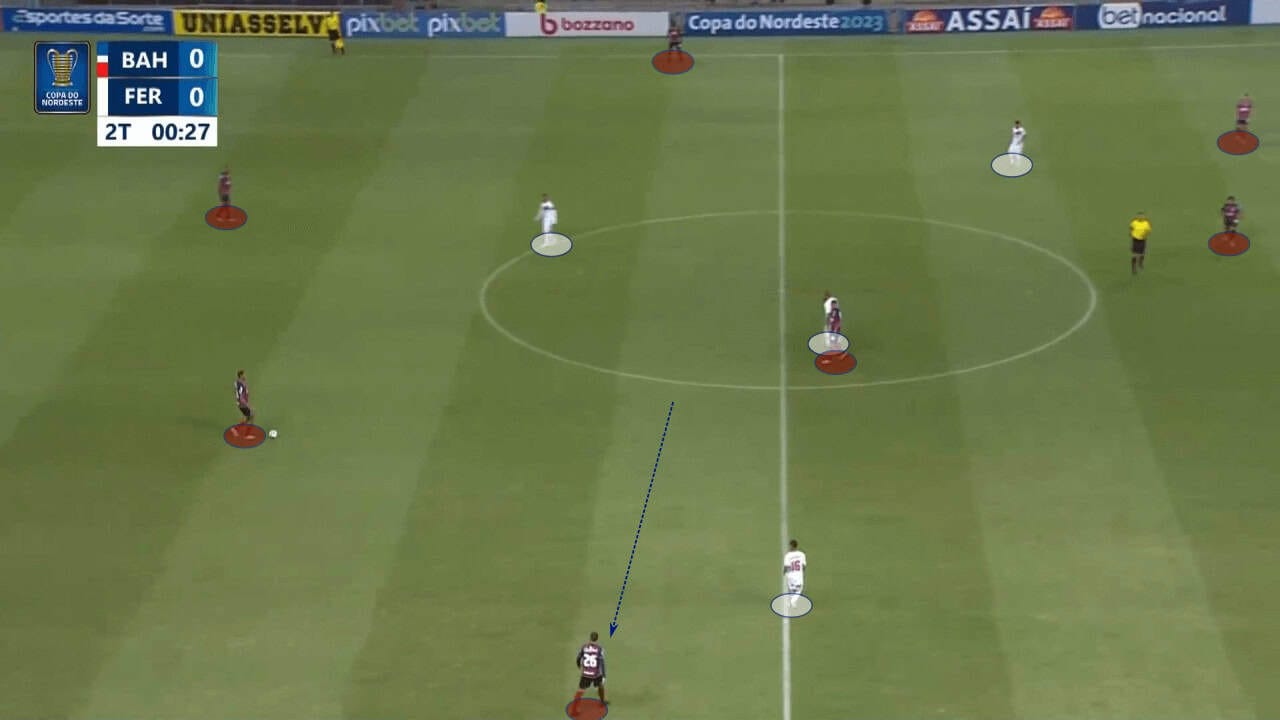
This last example serves to illustrate the geometrical inspiration behind this system. Following this zonal system, both vertically and horizontally, they are able to create optimal passing angles and an overall passing network. With numerous triangles and incredible tactical superiority, their progression is facilitated.
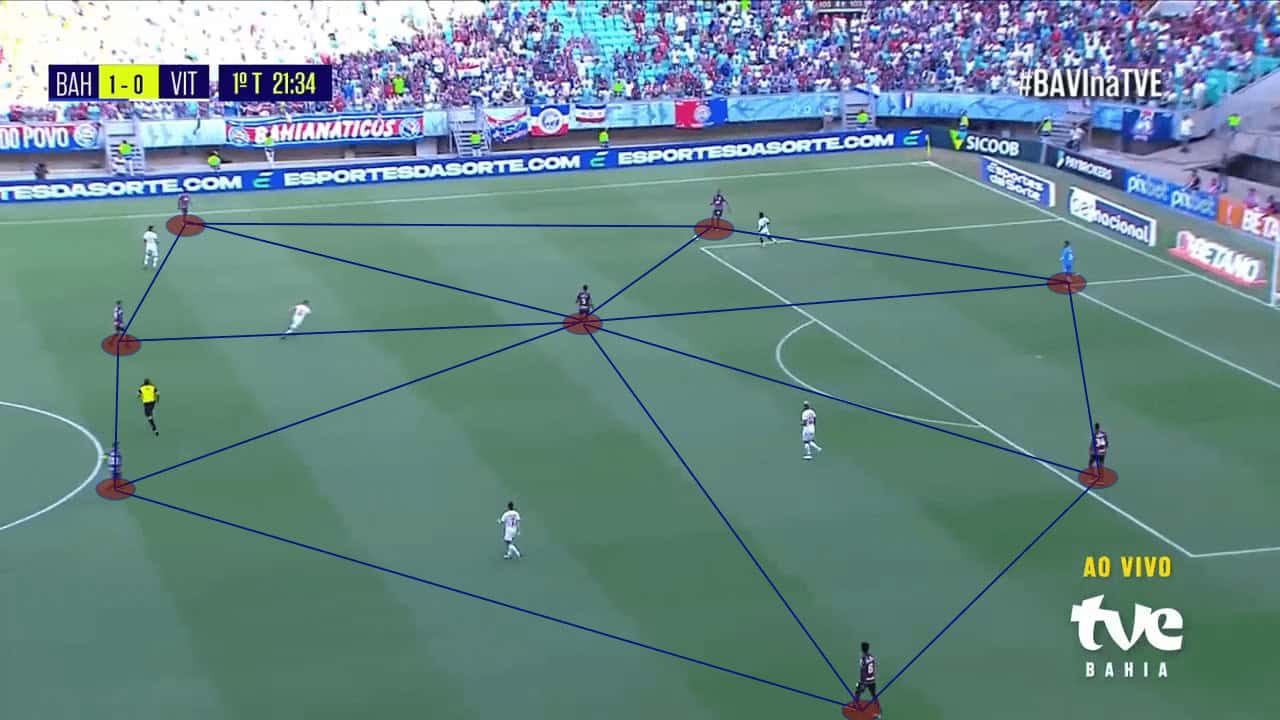
Manipulating space and opposition
Now that the structure and system through which they attack are clear, let’s take a look at how they progress and create. The image below outlines the spatial guidelines once again, highlighting the five vertical channels. Despite having possession on the left wing, Bahia maintain maximum width and expand the pitch entirely.
The three midfielders are spread across the three central channels, and the two wingers have drifted inside to the half-spaces. The fullbacks push high and wide to provide width and depth. The two centre-backs stay rather distant, roughly in each half-space. This creates the famous 2-3-5.
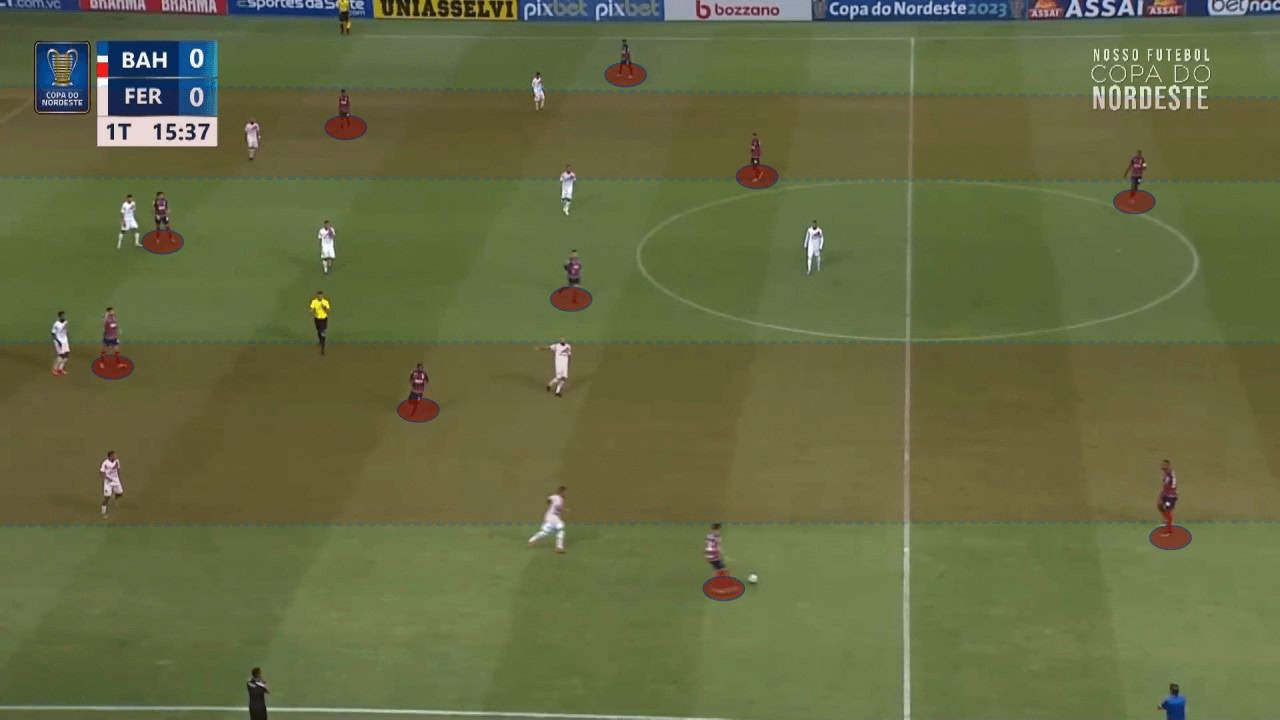
As examined earlier, this structure expands the pitch and stretches the defence, consequently stretching the passing lines. Additionally, the angles are optimal, both in immediate passing options and subsequent support.
In the example below, the right-back plays a diagonal pass into the half-space, and the defensive midfielder provides immediate support from a deeper diagonal angle. Meanwhile, the centre-forward drops in from deeper to provide an outlet in between the lines, should the pass sequence be completed.
In this specific example, Bahia did not exploit this possible route. Nonetheless, the idea and movements are slowly getting there from Paiva’s men.
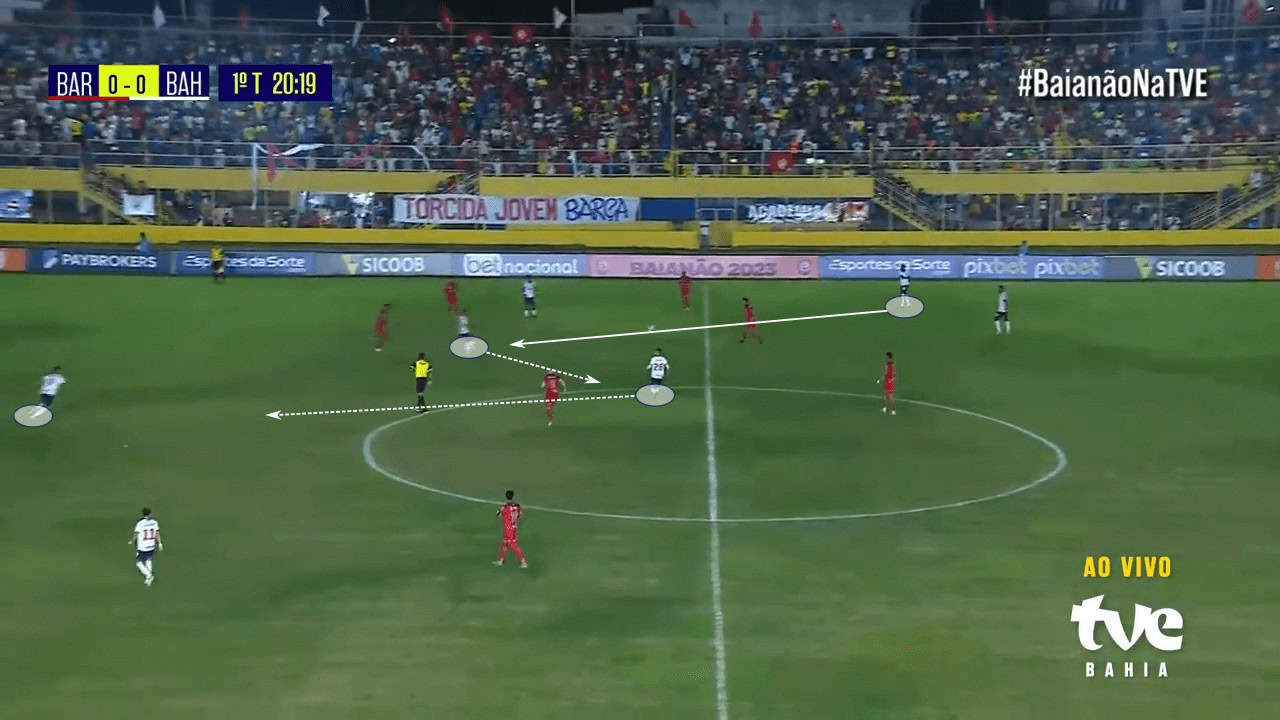
In another example, we can see a few more dynamics of this sort of ball progression. It starts with the centre-forward making a run into the space behind. The primary goal of this run is not to receive the ball but to lower the opposition’s backline and create depth. With this movement, the right winger gains dangerous space around him in between the lines.
The centre-back finds this vertical pass and breaks the first defensive line. After receiving, the right winger immediately has options with the right-back out wide, the defensive midfielder supporting from deep, and another midfielder in the central channel.
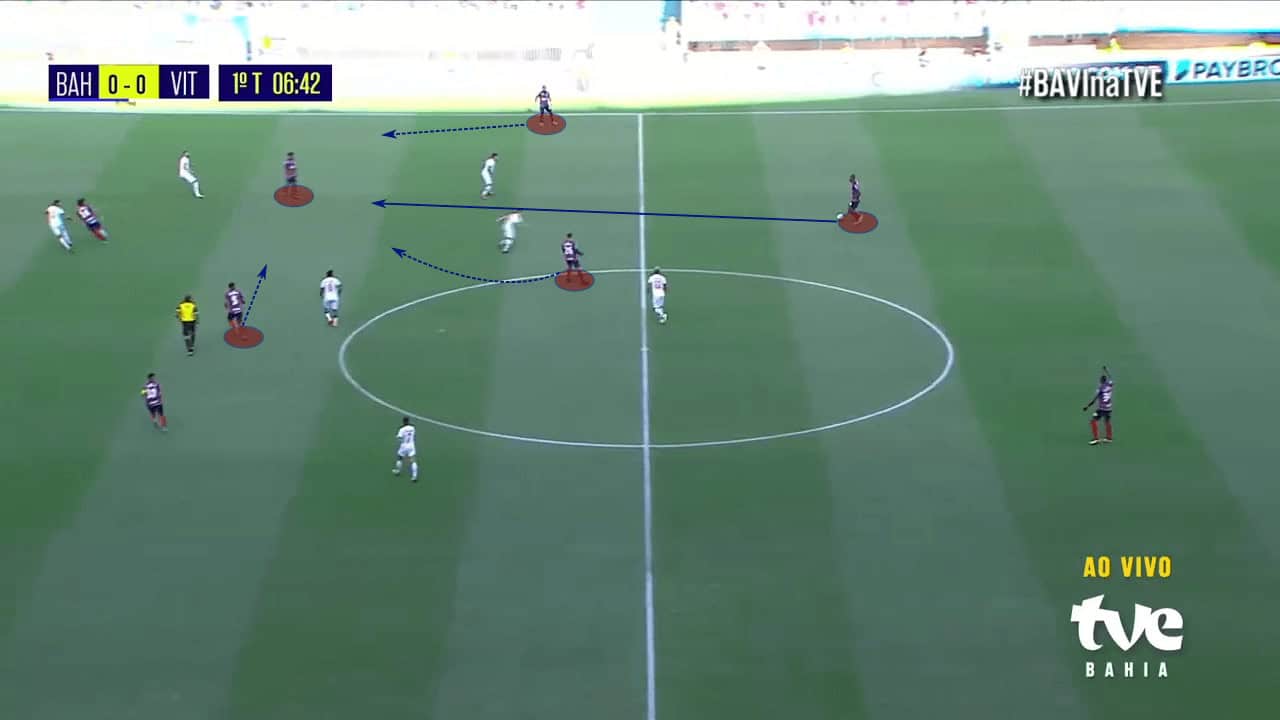
While width can stretch the opposition’s defensive lines, depth can create space between the defensive lines. In the example below, with an aggressive line of attackers, Paiva’s men pin the opposition’s backline. Each defender has an assignment, and one of Bahia’s players is left free to check into the space between the lines.
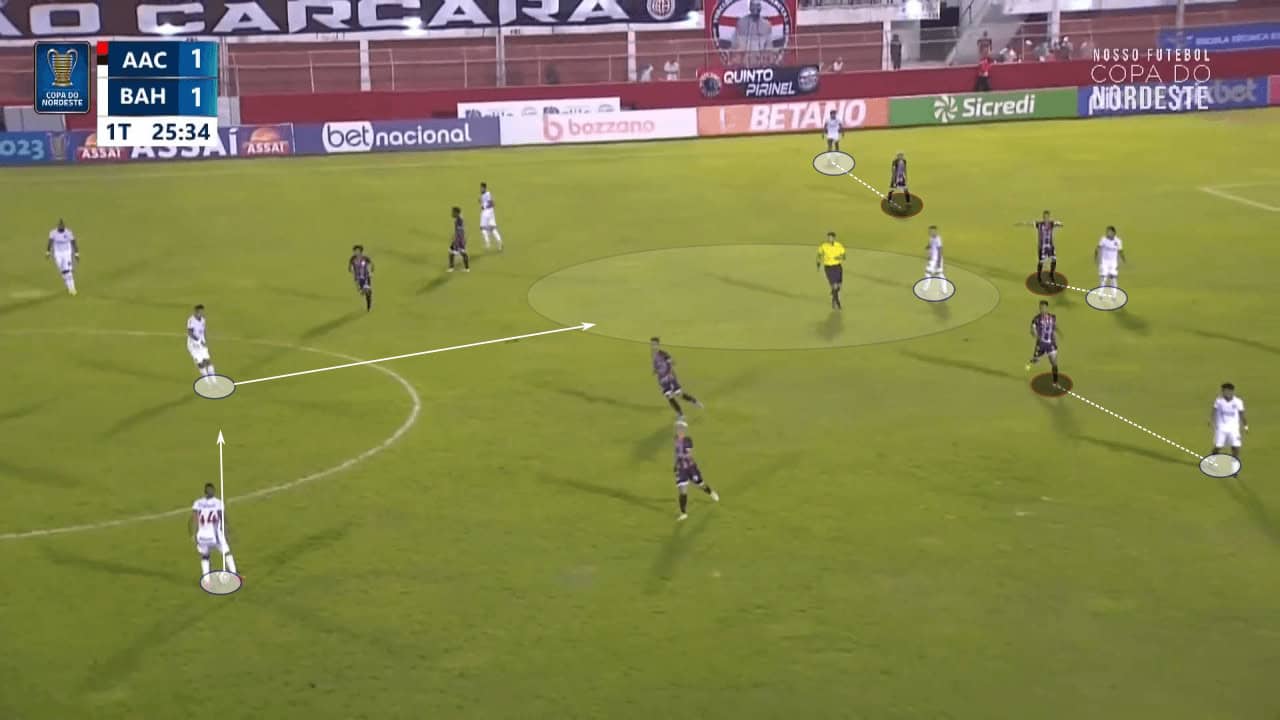
By following these zonal guidelines, it feels like Bahia always have an extra man on the pitch. They create these third-man options by pinning or attracting the opposition to certain places, essentially manipulating the defensive organisation with their positions and possession until they find that dangerous option to exploit.
In the example below, the right winger checks into the space between the lines, and after turning, he is in a 2v1 with his right back, who remained wide, against the opposition’s left back.
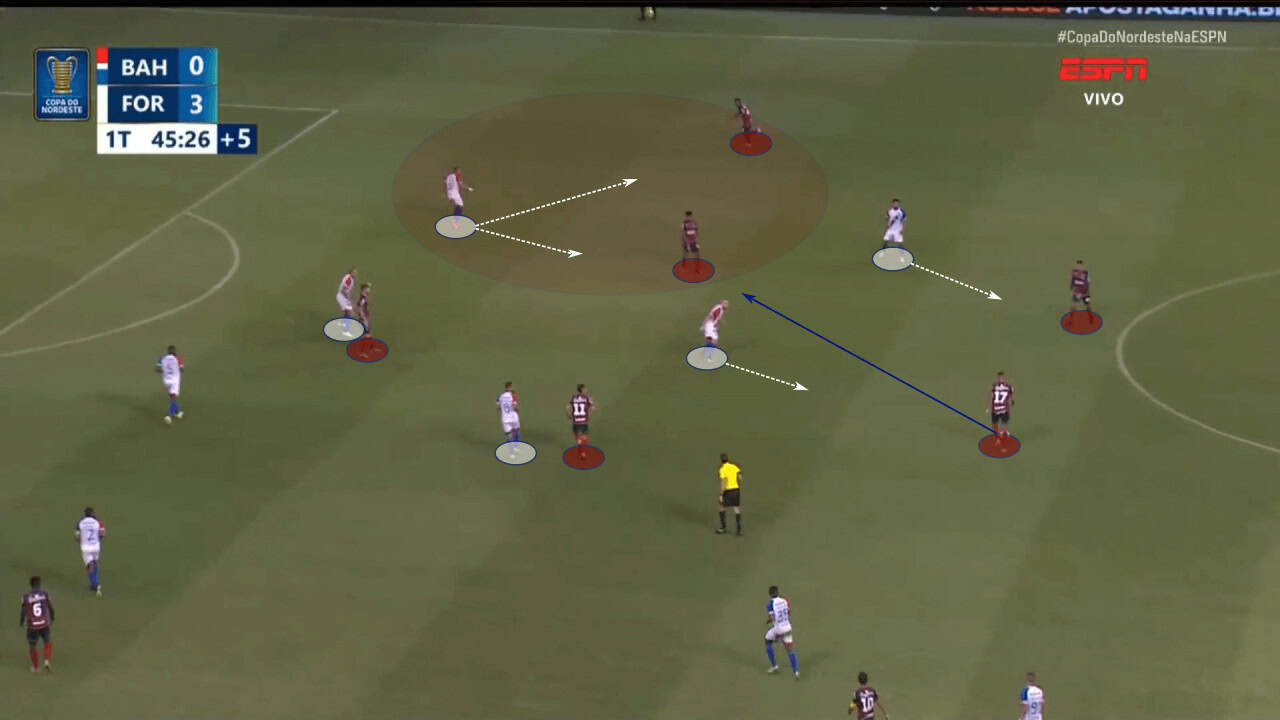
In a different example, we can see a very similar result. After exploring the right channels, Bahia recycle to the other side with short lateral passes. By maintaining maximum width the whole time, as they switch, they find a 2v1 in the backline with the opposition’s defender pinned out wide.
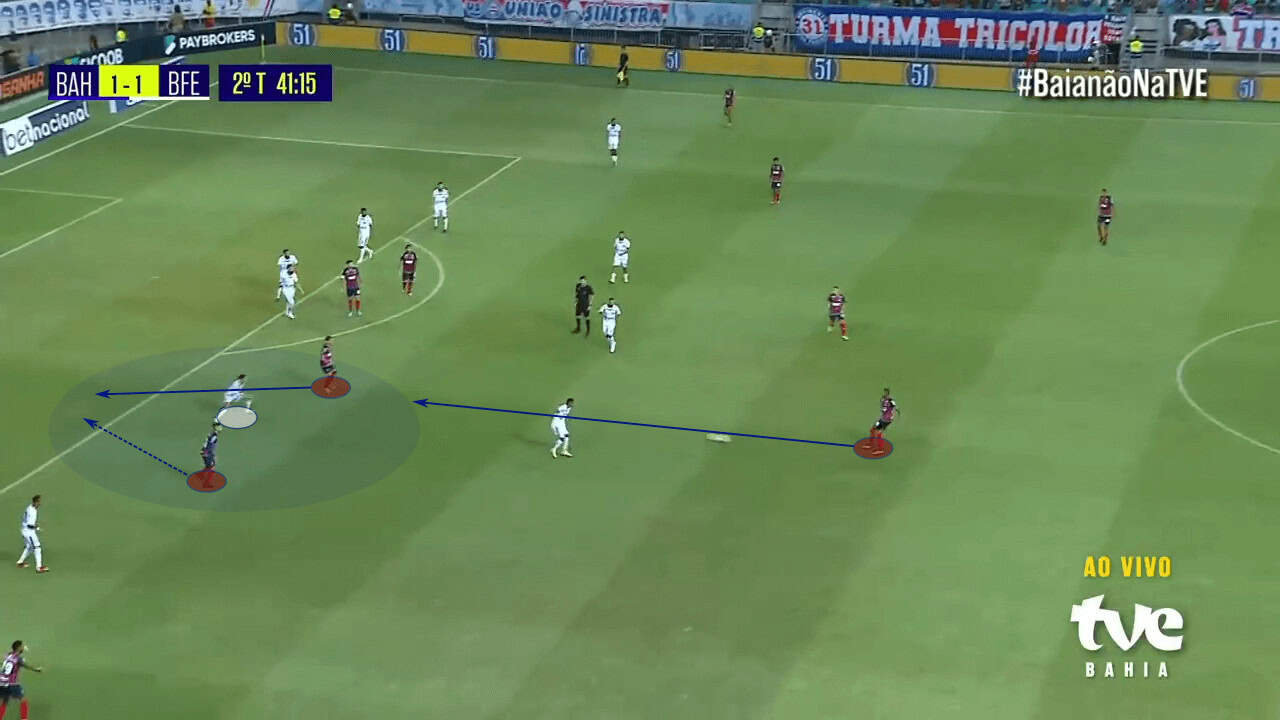
Bahia’s approach to possession under Renato Paiva is textbook Positional Play. The Portuguese manager must be given credit for implementing it so effectively in such a short period of time and going forward against tougher opposition, it will be interesting to see how it holds up.
High press variations
Defensively, there are no surprises again. With their aim to dominate and control the opposition, recovering the ball as soon as possible is key. In 2023, Bahia average an incredible 5.51 PPDA. Their high press has been extremely successful, and a lot of it has to do with the variations.
The perhaps default structure in their high press is a 4-4-2, with the attacking midfielder joining the centre-forward from their original 4-2-3-1. Their structure is extremely compact and narrow, and they do a fantastic job of moving as a unit. This can be seen in the example below.
The two centre-forwards lead the line and force the opposition to one side and keep them there. The opposite winger tucks in to further congest or “close off” the pitch. From there, it is a tight 4-2 structure with zonal markings and the touchline as an extra defender. Their coordination is already fantastic to perform the initial trap wide and then apply extreme pressure.
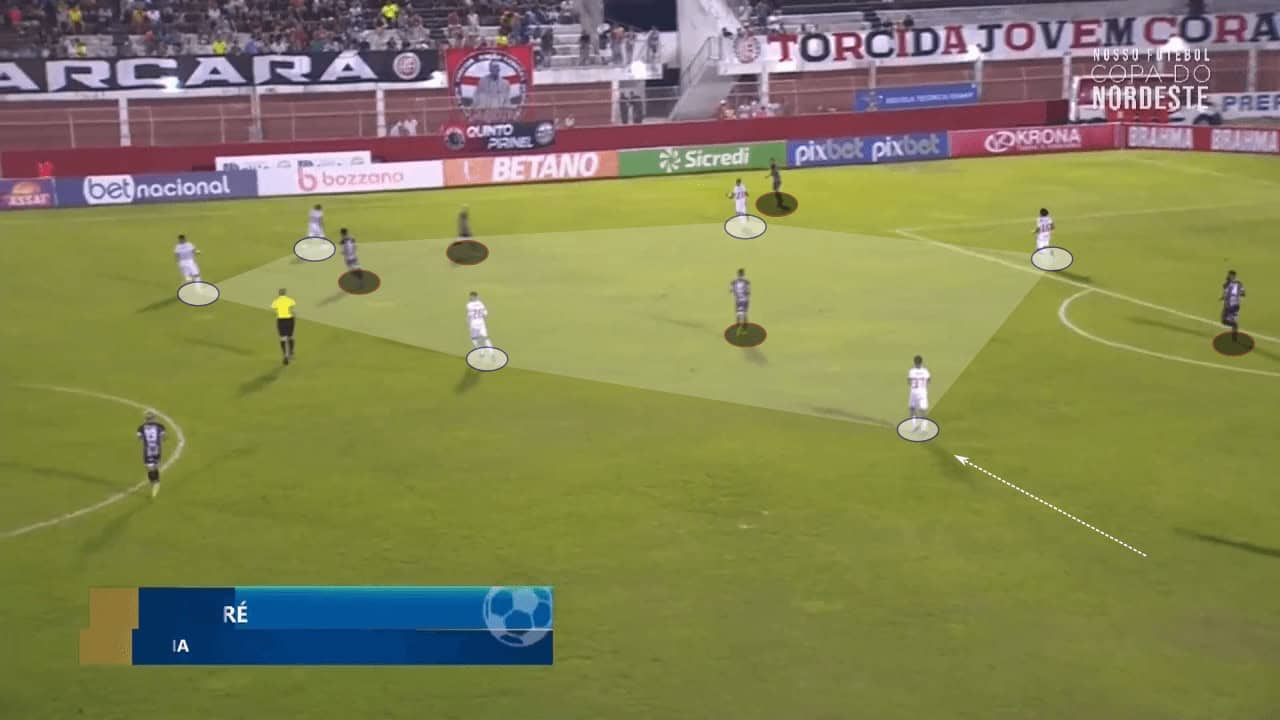
In a deeper block, the 4-4-2 can also be maintained. Again, it is very much zonal marking. The image below further illustrates this, with players having numerous possible pressing assignments, depending on where the ball goes. Although it requires extreme coordination and communication, this zonal system makes them very dynamic defensively.
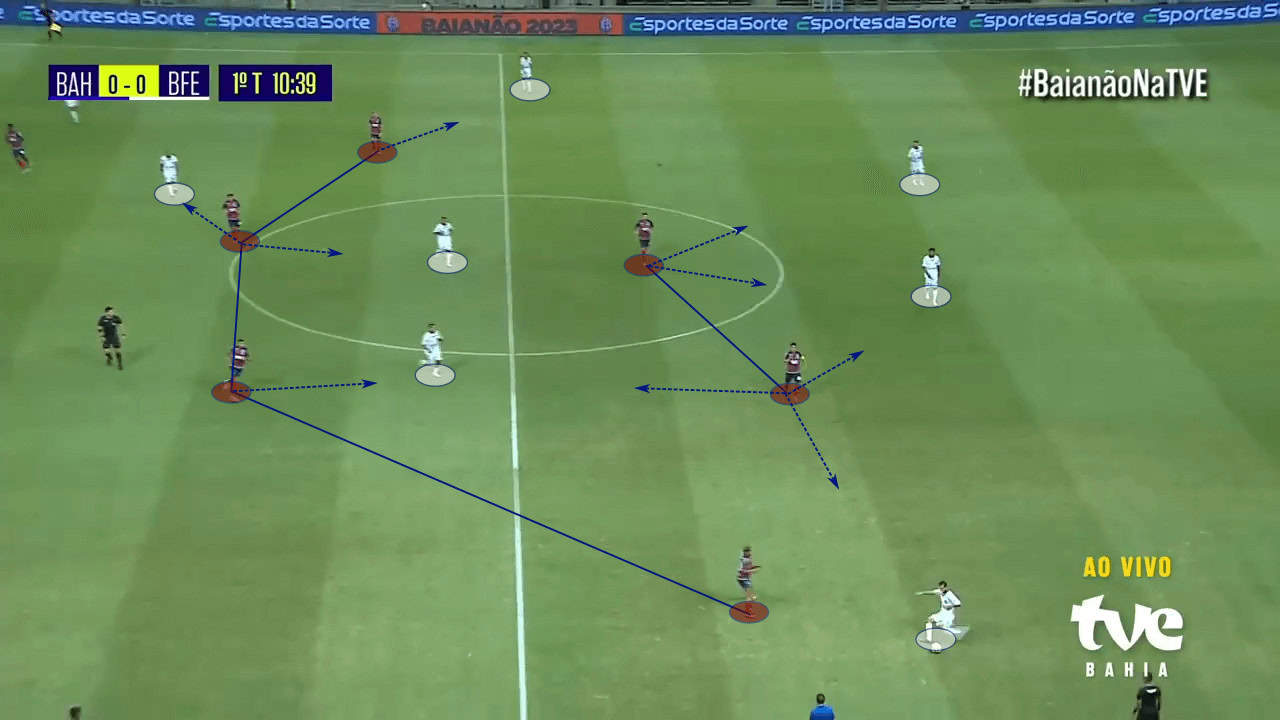
Renato Paiva has also adopted a 4-3-3 at times this season, depending on the opposition’s structure. In this structure, the front three remains the same and the midfield turns into a 1-2 rather than a 2-1. The behaviour and strategy in the press remain the same, as seen below. In the instance below specifically, the left-back jumps all the way up into the final third and the centre-back follows to provide cover.
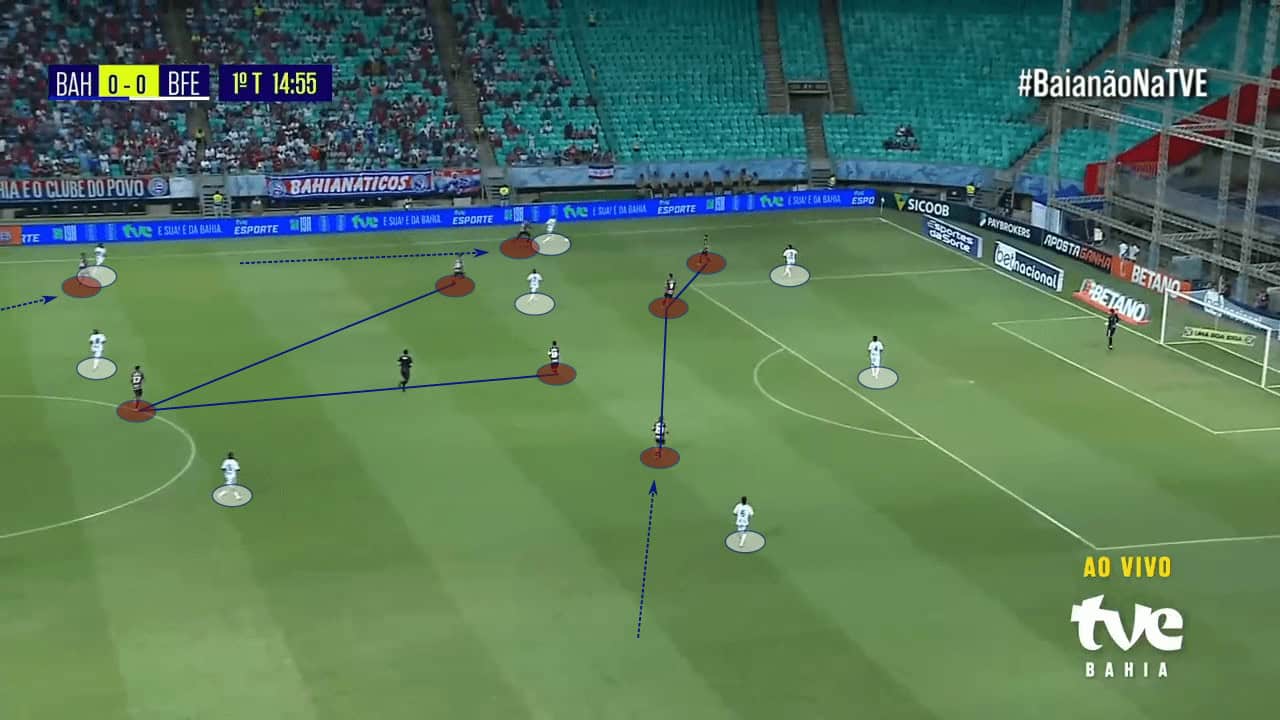
In this final instance, we can see a more structured example. The two central midfielders jump on the opposition’s double pivot, the centre-forward joins the nearest winger, and the opposite winger tucks in. If a player drops in from deeper, like in the image below, the nearest fullback follows. The 4-3-3 can be a much more aggressive structure than the 4-4-2, with the fullbacks getting more involved.
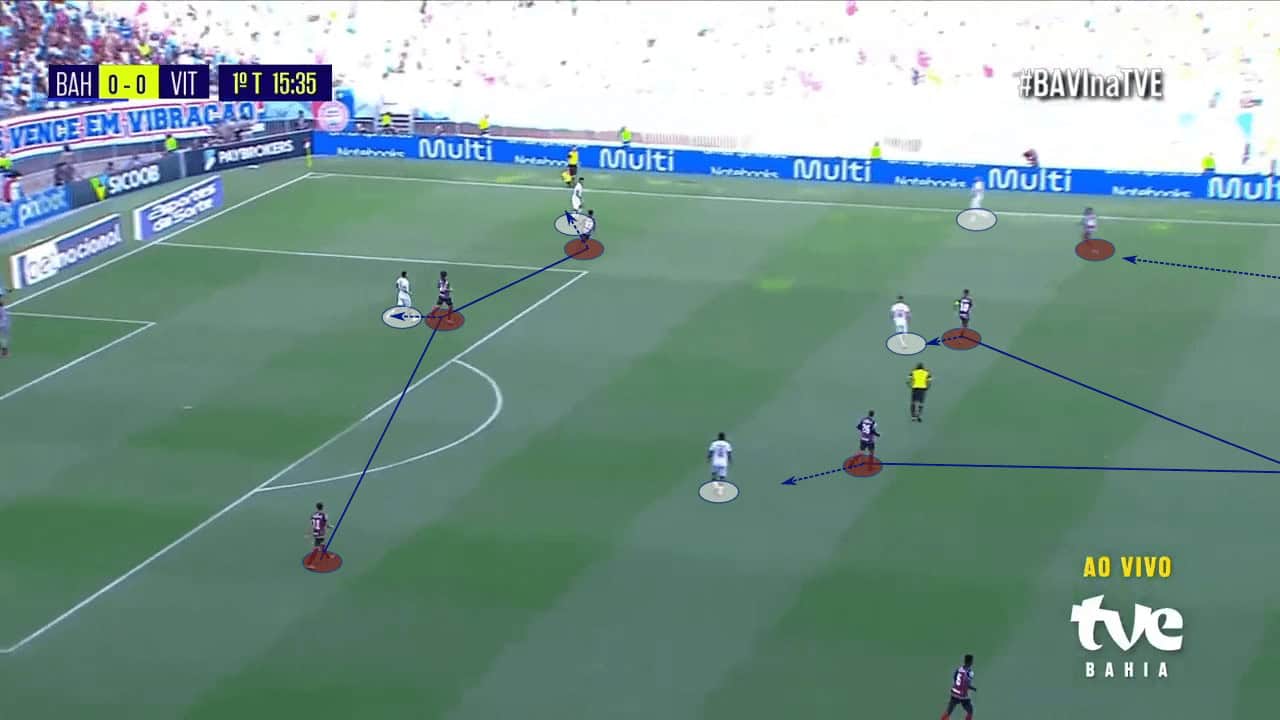
Conclusion
Renato Paiva’s work at City Football Group’s new Bahia is underway, and 11 matches in, the tactical identity is already in line with the other City clubs. The Tricolor are playing with an organised Positional Play approach, and so far, it has proven effective. Defensively, their work supports their aim to dominate and control matches, with an aggressive high press to recover the ball as soon as possible.
With intelligent recruitment and a fantastic managerial appointment, City Group have given Bahia the perfect setup for a path to the top. It will now be interesting to see the continuity of this project both on and off the pitch.





Comments